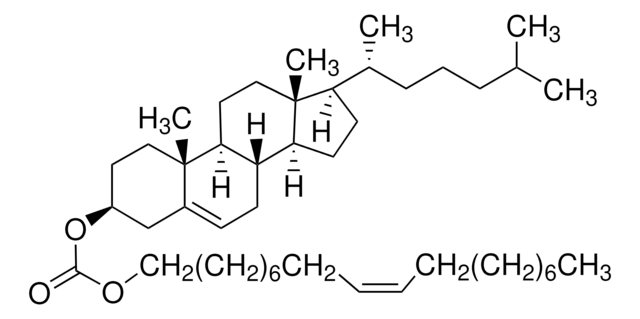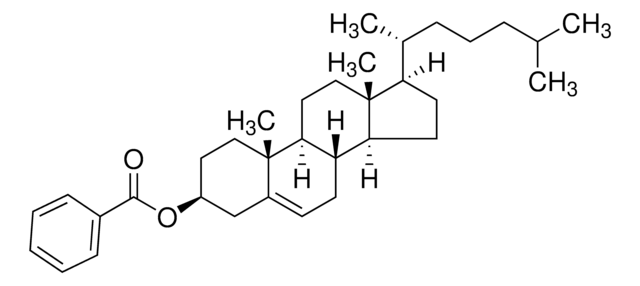328510
4′-Pentyl-4-biphenylcarbonitrile
liquid crystal (nematic), 98%
Synonym(s):
4-Cyano-4-pentylbiphenyl, 4-Pentyl-4-cyanobiphenyl, 5CB
Sign Into View Organizational & Contract Pricing
All Photos(2)
About This Item
Linear Formula:
CH3(CH2)4C6H4C6H4CN
CAS Number:
Molecular Weight:
249.35
EC Number:
MDL number:
UNSPSC Code:
12352103
PubChem Substance ID:
NACRES:
NA.23
Recommended Products
Assay
98%
form
liquid crystal (nematic)
refractive index
n20/D 1.532 (lit.)
bp
140-150 °C/0.5 mmHg (lit.)
density
1.008 g/mL at 25 °C (lit.)
SMILES string
CCCCCc1ccc(cc1)-c2ccc(cc2)C#N
InChI
1S/C18H19N/c1-2-3-4-5-15-6-10-17(11-7-15)18-12-8-16(14-19)9-13-18/h6-13H,2-5H2,1H3
InChI key
HHPCNRKYVYWYAU-UHFFFAOYSA-N
Related Categories
General description
4′-Pentyl-4-biphenylcarbonitrile (5CB) is a nematic liquid crystal. 5CB undergoes phase transition from crystalline to nematic then to isotropic state at 18oC and 35oC respectively. It may be produced by modifying biphenyl.2
Application
Attaching 5CB to an aqueous-liquid crystal interface by redox active surfactant has been investigated.
Signal Word
Warning
Hazard Statements
Precautionary Statements
Hazard Classifications
Skin Sens. 1
Storage Class Code
10 - Combustible liquids
WGK
WGK 3
Personal Protective Equipment
dust mask type N95 (US), Eyeshields, Gloves
Choose from one of the most recent versions:
Already Own This Product?
Find documentation for the products that you have recently purchased in the Document Library.
Jin Pan et al.
Nanomaterials (Basel, Switzerland), 8(6) (2018-06-13)
Resistive pressure sensors generally employ microstructures such as pores and pyramids in the active layer or on the electrodes to reduce the Young’s modulus and improve the sensitivity. However, such pressure sensors always exhibit complex fabrication process and have difficulties
Joo Song Lee et al.
Science (New York, N.Y.), 362(6416), 817-821 (2018-11-18)
Although polycrystalline hexagonal boron nitride (PC-hBN) has been realized, defects and grain boundaries still cause charge scatterings and trap sites, impeding high-performance electronics. Here, we report a method of synthesizing wafer-scale single-crystalline hBN (SC-hBN) monolayer films by chemical vapor deposition.
Yu Xia et al.
Advanced materials (Deerfield Beach, Fla.), 28(43), 9637-9643 (2016-10-08)
Two-dimensional liquid-crystal elastomer (LCE) sheets with preprogrammed topological defects are prepared by aligning liquid-crystal monomers within micropatterned epoxy channels, followed by photopolymerization. Upon heating, the LCE films form various three-dimensional structures in agreement with theoretical design. The miniaturized LCE actuators
Ahlam Nemati et al.
ACS nano, 13(9), 10312-10326 (2019-08-20)
The creation and transmission of chirality in molecular systems is a well-known, widely applied notion. Our understanding of how the chirality of nanomaterials can be controlled, measured, transmitted through space, and applied is less well understood. Dynamic assemblies for chiral
Makiko T Quint et al.
Scientific reports, 7(1), 17788-17788 (2017-12-21)
We present three-dimensional microshells formed by self-assembly of densely-packed 5 nm gold nanoparticles (AuNPs). Surface functionalization of the AuNPs with custom-designed mesogenic molecules drives the formation of a stable and rigid shell wall, and these unique structures allow encapsulation of cargo
Our team of scientists has experience in all areas of research including Life Science, Material Science, Chemical Synthesis, Chromatography, Analytical and many others.
Contact Technical Service









